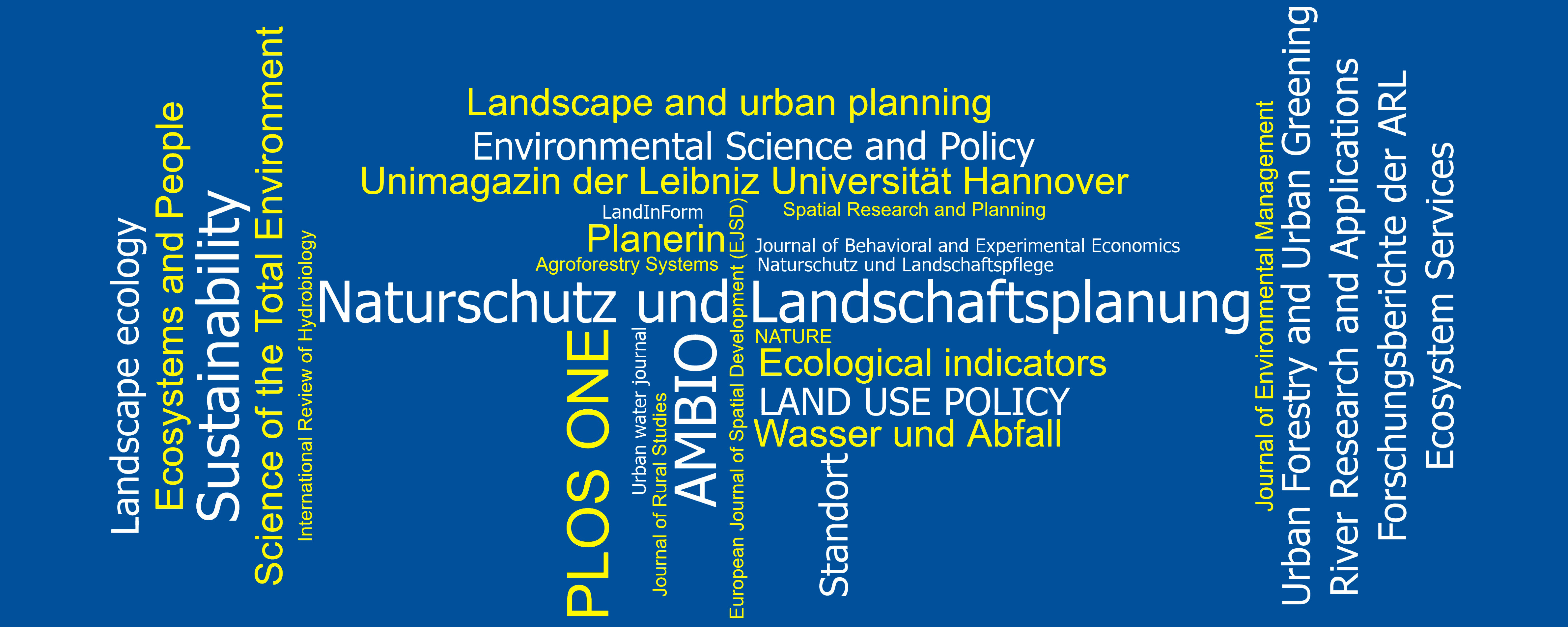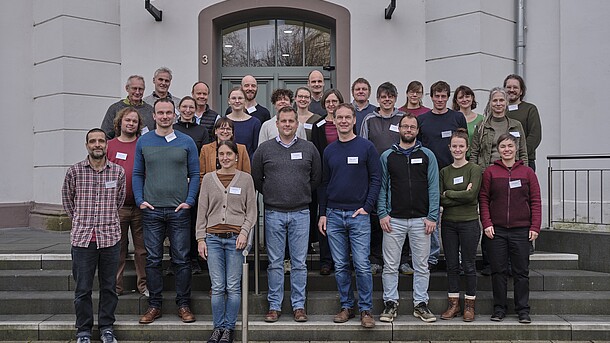Looking back at an eventful and inspiring AESOP YA Conference 2025



SEARCH FOR PUBLICATIONS
Showing results 181 - 200 out of 1633
2022
Guerrero, P., Haase, D., & Albert, C. (2022). Identifying Spatial Patterns and Ecosystem Service Delivery of Nature-Based Solutions. Environmental management, 69(4), 735-751. https://doi.org/10.1007/s00267-022-01613-y
Hack, J. (2022). Advances in implementing and promoting Nature-based Solutions in urban areas – A real-world lab experience from Costa Rica. Proceedings of the IAHR World Congress, SS-169-SS-180. https://doi.org/10.3850/IAHR-39WC2521-71192022SS934
Hermes, J., Boll, T., Wöbse, H. H., Ott, S., & von Haaren, C. (2022). Erfassen und Bewerten der Landschaftserlebnis- und Erholungsfunktion. In C. Albert, C. Galler, & C. von Haaren (Eds.), Landschaftsplanung (2. vollst. überarb. u. erw. Aufl. ed., pp. 335 - 359). Verlag Eugen Ulmer. https://doi.org/10.36198/9783838585796-335-359
Kanning, H. (2022). Nachhaltige Entwicklung: Die Große Transformation als gesellschaftliche Herausforderung im 21. Jahrhundert. In A. Baumast, & J. Pape (Eds.), Betriebliches Nachhaltigkeitsmanagement (pp. 23-55). (UTB Band; No. 3676). UTB Ulmer Verlag. https://www.utb.de/doi/epdf/10.36198/9783838550220-24-56
Kanning, H., Scholles, F., & Mancebo, F. (2022). The sustainable and participatory city: a challenging concept! In E. Gustedt, U. Grabski-Kieron, C. Demazière, & D. Paris (Eds.), Cities and Metropolises in France and Germany (pp. 145-161). (Forschungsberichte der ARL; Vol. 20). Verlag der ARL. https://nbn-resolving.org/urn:nbn:de:0156-1119087
Kanning, H., & Meyer, C. (2022). The understanding and meaning of knowledge transfer for research and education. In M. Abassiharofteh, J. Baier, A. Göb, I. Thimm, A. Eberth, F. Knaps, L. Vilja, & F. Zebner (Eds.), Spatial transformation: Processes, strategies, research design (pp. 9-26). (Forschungsberichte der ARL; Vol. 19). Verlag der ARL. https://nbn-resolving.org/urn:nbn:de:0156-08910228
Kanning, H. (2022). Wissenstransfer und Wissenschaftskommunikation im und für den Wandel. In A. Eberth, A. Goller, J. Günther, M. Hanke, V. Holz, A. Krug, K. Roncévic, & M. Singer-Brodowski (Eds.), Bildung für nachhaltige Entwicklung : Impulse zu Digitalisierung, Inklusion und Klimaschutz (pp. 329-344). Verlag Barbara Budrich. https://doi.org/10.3224/84742591, https://doi.org/10.25656/01:25541
Kempa, D., & Bargiel, D. (2022). Informationstechnologie in der Landschaftsplanung. In C. Albert, C. Galler, & C. von Haaren (Eds.), Landschaftsplanung (2. vollst. überarb. u. erw. Aufl. ed., pp. 129 - 149). Verlag Eugen Ulmer. https://doi.org/10.36198/9783838585796-130-150
Kempa, D., Bredemeier, B., von Haaren, C., Noll, S., Weller, M., & Bernhardt, J. J. (2022). MANUELA - Managementsystem Naturschutz für eine nachhaltige Landwirtschaft: Technische Dokumentation und bedienungsanleitung für Anwender. Institut für Umweltplanung, Leibniz Universität Hannover. https://doi.org/10.15488/11650
Kirsch-Stracke, R. (2022). Blume des Jahres 2022: Die Vierblättrige Einbeere (Paris quadrifolia L.) im Kreis Olpe. Südsauerland (HSO) Folge 287, 93( 2).
Kirsch-Stracke, R. (2022). Waldschulen und Waldklassenzimmer im Kreis Olpe vor über 100 Jahren. Südsauerland (HSO) Folge 288, 93(3).
Knaps, F., Herrmann, S., & Mölders, T. (2022). Landscape identity: Approaches to its conceptualisation, capture and integration into place branding processes. In Spatial transformation: processes, strategies, research design (pp. 164-178). (Forschungsberichte der ARL). Verlag der ARL. https://nbn-resolving.org/urn:nbn:de:0156-08911407
Knaps, F., Gottwald, S., Albert, C., & Herrmann, S. (2022). Using meaningful places as an indicator for sense of place in the management of social-ecological systems. Ecology and Society, 27(4), Article 9. https://doi.org/10.5751/ES-13340-270409
Koessler, A. K. (2022). Pledges and how social influence shapes their effectiveness. Journal of Behavioral and Experimental Economics, 98, Article 101848. https://doi.org/10.1016/j.socec.2022.101848
Koessler, A. K., Vorlaufer, T., & Fiebelkorn, F. (2022). Social norms and climate-friendly behavior of adolescents. PLOS ONE, 17(4), Article e0266847. https://doi.org/10.1371/journal.pone.0266847
Krätzig, S., Kunze, K., Warren-Kretzschmar, B., Galler, C., & von Haaren, C. (2022). Kommunikation und Partizipation in der Landschaftsplanung. In C. Albert, C. Galler, & C. von Haaren (Eds.), Landschaftsplanung (2. vollst. überarb. u. erw. Aufl. ed., pp. 575 - 586). Verlag Eugen Ulmer. https://doi.org/10.36198/9783838585796-575-586
Kuhn, U., Sander, A., & Neuendorf, F. (2022). Ziele und Maßnahmen zum Schutz und zur Entwicklung der Grundwasserdargebotsfunktion. In Landschaftsplanung (2. vollst. überarb. u. erw. Aufl. ed., pp. 427 - 436). Verlag Eugen Ulmer. https://doi.org/10.36198/9783838585796-427-436
Lamberg, J. (2022). Autonomer und flexibler ÖPNV als Beitrag zur Sicherung der Daseinsvorsorge in ländlichen Räumen? Eine Untersuchung im Regionalverband Großraum Braunschweig. (1. ed.) Cuvillier Verlag.
Lamberg, J. (2022). Identifying Key Factors in Planning and Implementing Autonomous Public Transport: An Investigation of Road- and Rail-bound Projects in Germany. European Journal of Spatial Development (EJSD), 19(3), 48 - 66. https://doi.org/10.5281/zenodo.6771627
Levin-Keitel, M., Othengrafen, F., Galler, C., & von Haaren, C. (2022). Umsetzung durch Integration in andere Planungen. In C. Albert, C. Galler, & C. von Haaren (Eds.), Landschaftsplanung (2. vollst. überarb. u. erw. Aufl. ed., pp. 517 - 539). Verlag Eugen Ulmer. https://doi.org/10.36198/9783838585796-517-539
Members of the Institute of Environmental Planning publish additional datasets connected to publications and reserach projects. The link takes you to the research portal of Leibniz Universität Hannover, which lists these datasets and links to their location on the web. The datasets are primarily open-access.





